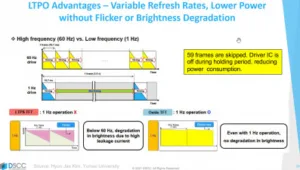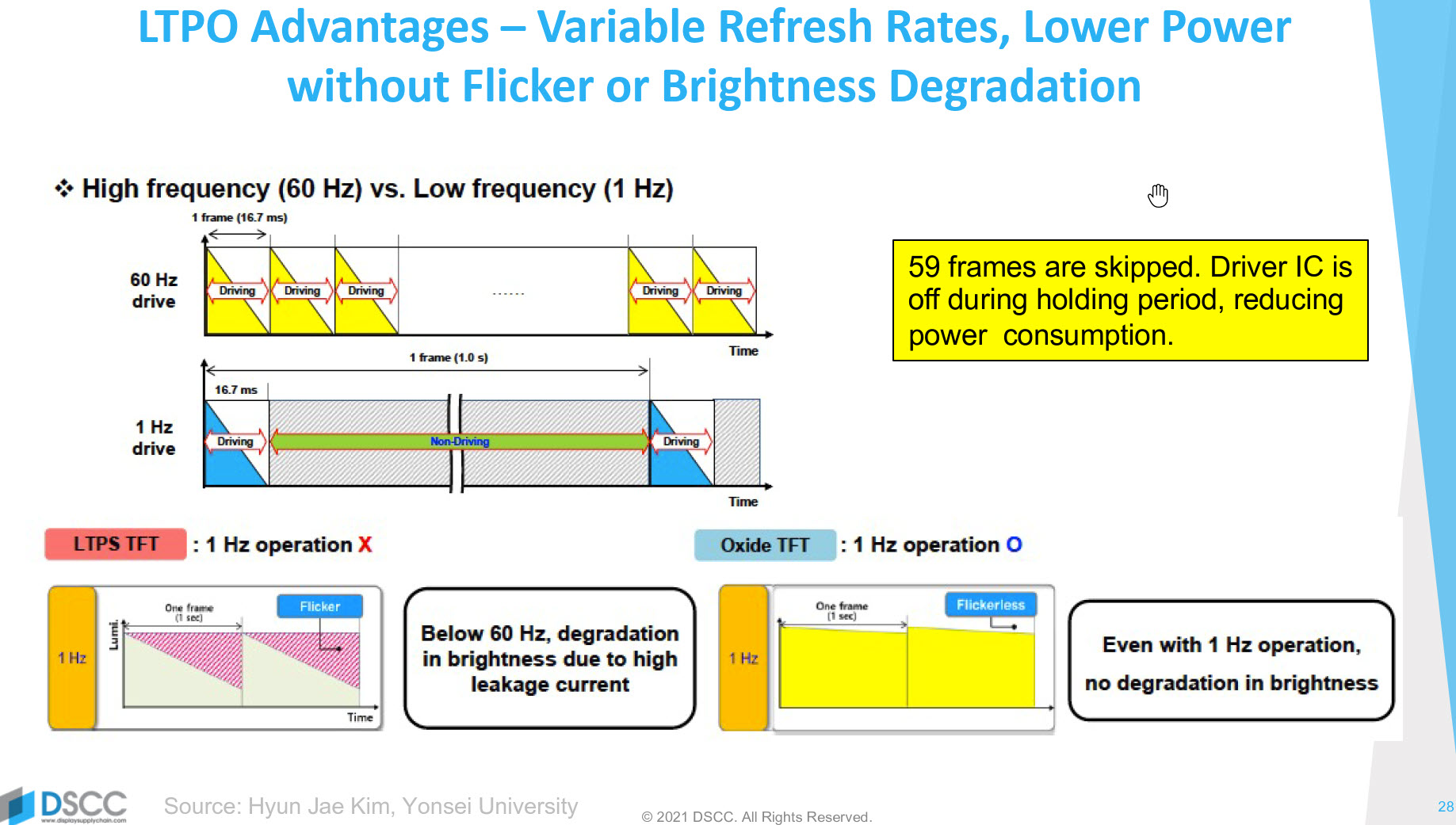For some time, I have been looking for a good explanation of the LTPO technology that is increasingly being used in display backplanes. I’m grateful to Ross Young for looking at this as part of his DSCC/SID Business Conference smartphone market presentation and making some interesting slides.
The LTPO acronym stands for Low Temperature Poly Oxide, and that might make you think that LTPO is an allotrope of the oxides (such as IGZO) as LTPS is an allotrope of silicon. I won’t cover that here as I most recently described what LTPS is here. However, LTPO is not a different version of an Oxide, but is a combination of LTPS and Oxide transistors.
LTPS has high mobility so allows the efficient transport of electrons for driving emissive displays such as OLEDs, miniLEDs or microLEDs where the energy for the pixel has to go through the backplane (compared to LCD transistors where the light and most of the energy comes from somewhere else). It’s a good technology for driving high brightness in OLEDs. However, it has a downside.
The Guilty Secret of LTPS
LTPS has a relatively high leakage current. That is to say, when the transistor is turned off, some current leaks through the transistor. That has become a problem as smartphones have looked to further extend battery life by reducing the refresh rate of the display. Reducing the refresh rate means that less power is used in the driving circuits.
However, if you reduce the refresh rate to, say 1Hz, to reduce driving power, the leakage of the LTPS means that the brightness will gradually decline during that period. When it’s refreshed, it brightens again and the net result is flicker.
Oxide transistors, on the other hand, have low leakage current. However, they have lower mobility, so if you use those to drive the OLED it’s hard to get the brightness and efficiency that you need.
LTPO gets over these issues by simply using an Oxide transistor to control the LTPS transistor. That eliminates the potential flicker as the IGZO maintains its state better than LTPS will and allows variable refresh rates to save power when needed. The Oxide transistor can also be used to ensure that the LTPS transistor is completely off.
(I was explaining this to someone and found a useful analogy in lighting. Domestic light dimmers usually have switches as well as variable luminance controls. When you want the light fully off, you use the switch part. In this way, the LTPS is like the variable control and the Oxide is like the switch).
The downside is that the technique means more complication in the manufacturing of the TFT substrates. LTPS and Oxide transistors are both difficult to make, for different reasons, so combining them can mean lower yields (which means higher costs) and increasing TACT times (reducing the speed at which displays can be made). More equipment is needed to make the devices as well, which again adds cost.
Another difficulty, Young said at the event, is that some of the manufacturing processes for the LTPS use hydrogen to passivate defects, but if there is too much hydrogen around, there can be a shift in the way that the transistor works, and the threshold voltage can shift. You also need to be very careful in how you design the LTPS transistor to minimise the hysteresis – the difference in the way it works when its switched on and switched off.
Other Benefits of LTPO
As well as reducing power consumption, once you have the facility to support variable refresh rates, as well as reducing them to get longer battery life, you can increase them to make touch displays more responsive and to make gaming better. And everybody knows that bigger numbers are usually better in Tech, don’t they? So 120Hz refresh must be better than 90Hz and 60Hz, mustn’t it?
The move to higher refresh rates has been helped by a reverse in the push to higher resolutions in smartphones. In fact, Young said, the resolution has typically been declining in flexible OLEDs, with QHD+ production share dropping from 38% to as below 10% in some quarters. If you have fewer pixels per ‘screenful’, it’s easier to drive the panel faster and also improves yields and reduces display cost. It helps, too, that consumers are happy to pay more for higher refresh rates, while it doesn’t add too much cost if you are also reducing the resolution!
LTPO has been increasing in its share of the overall (combined rigid and flexible OLEDs for smartphones) from 1% at the end of 2020 to 14% by the end of 2021. LTPO is already more than half of the market for displays for foldable phones. An increasing share of LTPO, because of the difficulty and increased investment needed helps the dominant player in the OLED market, Samsung’s Display business. (BR)



